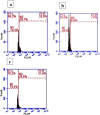Ameliorative effects of silymarin on HCl-induced acute lung injury in rats; role of the Nrf-2/HO-1 pathway
- PMID: 32133068
- PMCID: PMC7043873
- DOI: 10.22038/IJBMS.2019.14069
Ameliorative effects of silymarin on HCl-induced acute lung injury in rats; role of the Nrf-2/HO-1 pathway
Abstract
Objectives: Aspiration is a common cause of acute lung injury (ALI), which lacks an effective treatment. Inflammation and oxidative stress play key roles in ALI development. Silymarin is an active extract of Silybum marianum plant seeds (milk thistle). Silymarin has potent anti-inflammatory and antioxidant effects; however its role in aspiration induced ALI has not been investigated. The aim of this study is to investigate the role of silymarin in the treatment of hydrochloric acid (HCl) aspiration induced ALI and explores its mechanisms of action.
Materials and methods: The study included three groups of rats: Control non-treated group, ALI group (intra-tracheal HCl injected), and silymarin treated ALI group. White blood cells (WBCs) with differential count, oxidative stress parameters, B-cell lymphoma 2 (Bcl-2), transforming growth factor-beta (TGF-β), cyclooxygenase 2 (COX-2), nuclear factor erythroid 2-related factor-2 (Nrf-2), and heme oxygenase-1 (HO-1) were investigated. Lung tissue histopathology and immunohistochemical expression of survivin and proliferating cell nuclear antigen (PCNA) were also examined.
Results: The results of the study showed that HCL caused histopathological changes in ALI with leukocytopenia and increased oxidative stress biomarkers. It increased TGF-β, up-regulated mRNA expression of COX-2, Nrf-2, and HO-1 and increased survivin and PCNA but decreased Bcl-2. Silymarin ameliorated the histopathological lung injury with further up-regulation of Nrf-2 and HO-1 mRNA and decreased the inflammatory and fibrotic parameters together with up-regulation of the anti-apoptotic and the proliferation parameters.
Conclusion: The protective effect of silymarin against ALI is mediated by Nrf-2/HO-1 pathway with subsequent antioxidant, anti-inflammatory, antiapoptotic, and proliferating activities.
Keywords: Acute lung injury; Fibrosis; Heme oxygenase-1; Silymarin; Survivin.
Conflict of interest statement
The authors declare that there are no conflicts of interest regarding the publication of this paper.
Figures






Similar articles
-
Inhibition of endotoxin-induced acute lung injury in rats by bone marrow-derived mesenchymal stem cells: Role of Nrf2/HO-1 signal axis in inhibition of NLRP3 activation.Biochem Biophys Res Commun. 2021 Apr 30;551:7-13. doi: 10.1016/j.bbrc.2021.03.009. Epub 2021 Mar 10. Biochem Biophys Res Commun. 2021. PMID: 33713981
-
Silymarin attenuates paraquat-induced lung injury via Nrf2-mediated pathway in vivo and in vitro.Clin Exp Pharmacol Physiol. 2015 Sep;42(9):988-998. doi: 10.1111/1440-1681.12448. Clin Exp Pharmacol Physiol. 2015. PMID: 26173462
-
Alleviation of Acute Lung Injury in Rats with Sepsis by Resveratrol via the Phosphatidylinositol 3-Kinase/Nuclear Factor-Erythroid 2 Related Factor 2/Heme Oxygenase-1 (PI3K/Nrf2/HO-1) Pathway.Med Sci Monit. 2018 May 30;24:3604-3611. doi: 10.12659/MSM.910245. Med Sci Monit. 2018. PMID: 29844304 Free PMC article.
-
Protection Against Drug-Induced Liver Injuries Through Nutraceuticals via Amelioration of Nrf-2 Signaling.J Am Nutr Assoc. 2023 Jul;42(5):495-515. doi: 10.1080/27697061.2022.2089403. Epub 2022 Jun 30. J Am Nutr Assoc. 2023. PMID: 35771985 Review.
-
The clinical anti-inflammatory effects and underlying mechanisms of silymarin.iScience. 2024 Oct 9;27(11):111109. doi: 10.1016/j.isci.2024.111109. eCollection 2024 Nov 15. iScience. 2024. PMID: 39507256 Free PMC article. Review.
Cited by
-
Chronic Intermittent Hypoxia Reduces the Effects of Glucosteroid in Asthma via Activating the p38 MAPK Signaling Pathway.Front Physiol. 2021 Aug 27;12:703281. doi: 10.3389/fphys.2021.703281. eCollection 2021. Front Physiol. 2021. PMID: 34512379 Free PMC article.
-
A systematic review of the protective effects of silymarin/silibinin against doxorubicin-induced cardiotoxicity.Cancer Cell Int. 2023 May 10;23(1):88. doi: 10.1186/s12935-023-02936-4. Cancer Cell Int. 2023. PMID: 37165384 Free PMC article. Review.
-
Effect of Silymarin Supplementation in Lung and Liver Histological Modifications during Exercise Training in a Rodent Model.J Funct Morphol Kinesiol. 2021 Aug 30;6(3):72. doi: 10.3390/jfmk6030072. J Funct Morphol Kinesiol. 2021. PMID: 34564191 Free PMC article.
-
Phyto-pharmacological perspective of Silymarin: A potential prophylactic or therapeutic agent for COVID-19, based on its promising immunomodulatory, anti-coagulant and anti-viral property.Phytother Res. 2021 Aug;35(8):4246-4257. doi: 10.1002/ptr.7084. Epub 2021 Apr 4. Phytother Res. 2021. PMID: 33817867 Free PMC article. Review.
-
Potential of rosmarinic acid to ameliorate toxic effects of diethyl methoxy thio‑phosphoryl thio‑succinate on albino wistar rats' lung, mast cell infiltration inhibitory pathway.Food Sci Nutr. 2021 Jun 1;9(7):3593-3601. doi: 10.1002/fsn3.2316. eCollection 2021 Jul. Food Sci Nutr. 2021. PMID: 34262720 Free PMC article.
References
-
- Qing R, Huang Z, Tang Y, Xiang Q, Yang F. Cordycepin alleviates lipopolysaccharide-induced acute lung injury via Nrf2/HO-1 pathway. Int Immunopharmacol. 2018;60:18–25. - PubMed
-
- Qian L, Zhao Y, Guo L, Li S, Wu X. Activating transcription factor 3 (ATF3) protects against lipopolysaccharide-induced acute lung injury via inhibiting the expression of TL1A. J Cell Physiol. 2017;232:3727–3734. - PubMed
-
- Ashbaugh DG, Bigelow DB, Petty TL, Levine BE. Acute respiratory distress in adults. Lancet. 1967;2:319–323. - PubMed
-
- Tsushima K, King LS, Aggarwal NR, De Gorordo A, D’Alessio FR, Kubo K. Acute lung injury review. Internal medicine. 2009;48:621–630. - PubMed
-
- Reiss LK, Uhlig U, Uhlig S. Models and mechanisms of acute lung injury caused by direct insults. Eur J Cell Biol. 2012;91:590–601. - PubMed
LinkOut - more resources
Full Text Sources
Research Materials
Miscellaneous
